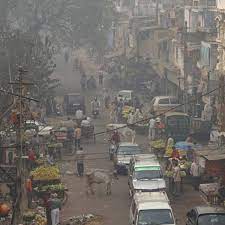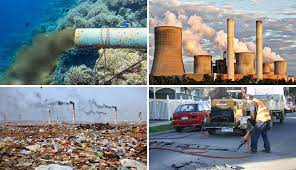The Four (4) Main Types of Pollution
The following are the four (4) main types of pollution;
1. Air Pollution
Human contamination of Earth’s atmosphere can take many forms and has existed since humans first began to use fire for agriculture, heating, and cooking. During the Industrial Revolution of the 18th and 19th centuries, however, air pollution became a major problem.
Urban air pollution is commonly known as smog. The dark smog is generally a smoky mixture of carbon monoxide and organic compounds from incomplete combustion (burning) of fossil fuels such as coal, and sulfur dioxide from impurities in the fuels.
As the smog ages and reacts with oxygen, organic and sulfuric acids condense as droplets, increasing the haze.
Smog developed into a major health hazard by the 20th century. In 1948, 19 people died and thousands were sickened by smog in the small U.S. steel-mill town of Donora, Pennsylvania. In 1952, about 4,000 Londoners died of its effects.
A second type of smog, photochemical smog is caused by combustion in car, truck, and airplane engines, which produces nitrogen oxides and releases hydrocarbons from unburned fuels.
Sunlight causes the nitrogen oxides and hydrocarbons to combine and turn oxygen into ozone, a chemical agent that attacks rubber, injures plants, and irritates lungs. The hydrocarbons are oxidized into materials that condense and form a visible, pungent haze.
Eventually most pollutants are washed out of the air by rain, snow, fog, or mist, but only after travelling and covering large distances, sometimes across continents. As pollutants build up in the atmosphere, sulfur and nitrogen oxides are converted into acids that mix with rain.
This acid rain falls in lakes and on forests, where it can lead to the death of fish and plants, and damage entire ecosystems. Eventually the contaminated lakes and forests may become lifeless.
Regions that are downwind of heavily industrialized areas, such as Europe and the eastern United States and Canada, are the hardest hit by acid rain. Acid rain can also affect human health and man-made objects; it is slowly dissolving historic stone statues and building facades in London, Athens, and Rome.
One of the greatest challenges caused by air pollution is global warming, an increase in Earth’s temperature due to the buildup of certain atmospheric gases such as carbon dioxide. With the heavy use of fossil fuels in the 20th century, atmospheric concentrations of carbon dioxide have risen dramatically.
Carbon dioxide and other gases, known as greenhouse gases, reduce the escape of heat from the planet without blocking radiation coming from the Sun. Air pollution can also damage the upper atmospheric region known as the stratosphere.
Excessive production of chlorine-containing compounds such as chlorofluorocarbons (CFCs) (compounds formerly used in refrigerators, air conditioners, and in the manufacture of polystyrene products) has depleted the stratospheric ozone layer, creating a hole above Antarctica that lasts for several weeks each year.
As a result, exposure to the Sun’s harmful rays has damaged aquatic and terrestrial wildlife and threatens human health in high-latitude regions of the northern and southern hemispheres.

2. Water Pollution
The demand for fresh water rises continuously as the world’s population grows. From 1940 to 1990 withdrawals of fresh water from rivers, lakes, reservoirs, and other sources increased fourfold.
Sewage, industrial wastes, and agricultural chemicals such as fertilizers and pesticides are the main causes of water pollution. In developing nations, more than 95 percent of urban sewage is discharged untreated into rivers and bays, creating a major human health hazard.
Water runoff, a nonpoint source of pollution, carries fertilizing chemicals such as phosphates and nitrates from agricultural fields and yards into lakes, streams, and rivers. These combine with the phosphates and nitrates from sewage to speed the growth of algae, a type of plantlike organism.
The water body may then become choked with decaying algae, which severely depletes the oxygen supply. This process, called eutrophication, can cause the death of fish and other aquatic life.
Read Also: The Application of Biotechnology to Waste Management
Agricultural runoff may be to blame for the growth of a toxic form of algae called Pfiesteriapiscicida, which was responsible for killing large amounts of fish in bodies of water from the Delaware Bay to the Gulf of Mexico in the late 1990s. Runoff also carries toxic pesticides and urban and industrial wastes into lakes and streams.
Erosion, which is the wearing away of the topsoil by wind and rain, also contributes to water pollution. Soil and silt fine sediment) washed from logged hillsides, plowed fields, or construction sites, can clog waterways and kill aquatic vegetation.
Even small amounts of silt can eliminate desirable fish species. For example, when logging removes the protective plant cover from hillsides, rain may wash soil and silt into streams, covering the gravel beds that trout or salmon use for spawning.
The marine fisheries supported by ocean ecosystems are an essential source of protein, particularly for people in developing countries. Yet pollution in coastal bays, estuaries, and wetlands threatens fish stocks already depleted by overfishing.
In 1989, 260,000 barrels of oil spilled from the oil tanker Exxon Valdez into Alaska’s Prince William Sound, a pristine and rich fishing ground. In 1999 there were 8,539 reported spills in and around U.S. waters, involving 4.4 billion liters (1.2 billion gallons) of oil.
3. Soil Pollution
Soil is a mixture of mineral, plant, and animal materials that form during a long process that may take thousands of years. It is necessary for most plant growth and is essential for all agricultural production.
Soil pollution is a buildup of toxic chemical compounds, salts, pathogens (disease-causing organisms), or radioactive materials that can affect plant and animal life.
Unhealthy soil management methods have seriously degraded soil quality, causing soil pollution, and enhanced erosion.
Treating the soil with chemical fertilizers, pesticides, and fungicides interferes with the natural processes occurring within the soil and destroys useful organisms such as bacteria, fungi, and other microorganisms.
For instance, strawberry farmers in California fumigate the soil with methyl bromide to destroy organisms that may harm young strawberry plants.
This process indiscriminately kills even beneficial microorganisms and leaves the soil sterile and dependent upon fertilizer to support plant growth. This results in heavy fertilizer use and increases polluted runoff into lakes and streams.
4. Noise Pollution
Unwanted sound, or noise, such as that produced by airplanes, traffic, or industrial machinery, is considered a form of pollution. Noise pollution is at its worst in densely populated areas.
It can cause hearing loss, stress, high blood pressure, sleep loss, distraction, and lost productivity. Sounds are produced by objects that vibrate at a rate that the ear can detect.
This rate is called frequency and is measured in hertz, or vibrations per second. Most humans can hear sounds between 20 and 20,000 hertz, while dogs can hear high-pitched sounds up to 50,000 hertz.
While high-frequency sounds tend to be more hazardous and more annoying to hearing than low-frequency sounds, most noise pollution damage is related to the intensity of the sound, or the amount of energy it has.
Measured in decibels, noise intensity can range from zero, the quietest sound the human ear can detect, to over 160 decibels. Conversation takes place at around 40 decibels, a subway train is about 80 decibels, and a rock concert is from 80 to 100 decibels.
The intensity of a nearby jet taking off is about 110 decibels. The threshold for pain, tissue damage, and potential hearing loss in humans is 120 decibels. Long-lasting, high-intensity sounds are the most damaging to hearing and produce the most stress in humans.
Solutions to noise pollution include adding insulation and sound-proofs to doors, walls, and ceilings; using ear protection, particularly in industrial working areas; planting vegetation to absorb and screen out noise pollution; and zoning urban areas to maintain a separation between residential areas and zones of excessive noise.
In summary, pollution, contamination of Earth’s environment with materials that interfere with human health, the quality of life, or the natural functioning of ecosystems (living organisms and their physical surroundings).
Read Also : Meaning of Pollution, Primary and Secondary Effects of Pollution
Although some environmental pollution is as a result of natural causes such as volcanic eruptions, most is caused by human activities.
Environmental pollution is one of the most horrible ecological crises the world is subjected today. The greatest challenges caused by air pollution is global warming
Sewage, industrial wastes, and agricultural chemicals such as fertilizers and pesticides are the main causes of water pollution
Soil pollution is a buildup of toxic chemical compounds, salts, pathogens (disease-causing organisms), or radioactive materials that can affect plant and animal life. Ecosystem functions may be impaired or destroyed by pollution.



